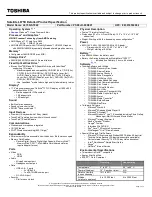
Removing Automatic DriveLock protection
To remove DriveLock protection in Computer Setup, follow these steps:
1.
Turn on or restart the computer, and then press
esc
or hold down the volume button while the
“Hold the Volume Down button to enter the BIOS Startup Menu” message is displayed at the
bottom of the screen.
2.
Press
f10
to enter Computer Setup.
3.
Use a pointing device or the arrow keys to select Security > Hard Drive Tools > Automatic
DriveLock, and then follow the on-screen instructions.
4.
Enter the BIOS Administrator password, and then follow the on-screen instructions.
5.
Use a pointing device or the arrow keys to select an internal hard drive, and then follow the on-
screen instructions.
6.
Use a pointing device or the arrow keys to select Disable protection.
7.
To save your changes and exit Computer Setup, click the Save icon in the lower-left corner of
the screen, and then follow the on-screen instructions.
– or –
Use the arrow keys to select Main > Save Changes and Exit, and then follow the on-screen
instructions.
Using antivirus software
When you use the computer to access e-mail, a network, or the Internet, you potentially expose it to
computer viruses. Computer viruses can disable the operating system, programs, or utilities, or cause
them to function abnormally.
Antivirus software can detect most viruses, destroy them, and, in most cases, repair any damage they
have caused. To provide ongoing protection against newly discovered viruses, antivirus software
must be kept up to date.
Windows Defender is preinstalled on your computer. It is strongly recommended that you continue to
use an antivirus program in order to fully protect your computer.
For more information about computer viruses, access HP Support Assistant. To access HP Support
Assistant, from the Start button, select the HP Support Assistant application.
Using firewall software
Firewalls are designed to prevent unauthorized access to a system or network. A firewall can be a
software program you install on your computer and/or network, or it can be a solution made up of
both hardware and software.
There are two types of firewalls to consider:
●
Host-based firewalls—Software that protects only the computer it is installed on.
●
Network-based firewalls—Installed between your DSL or cable modem and your home network
to protect all the computers on the network.
When a firewall is installed on a system, all data sent to and from the system is monitored and
compared with a set of user-defined security criteria. Any data that does not meet those criteria is
blocked.
56 Chapter 9 Security
Содержание Pro x2 612 G1
Страница 1: ...User Guide ...
Страница 4: ...iv Safety warning notice ...
















































